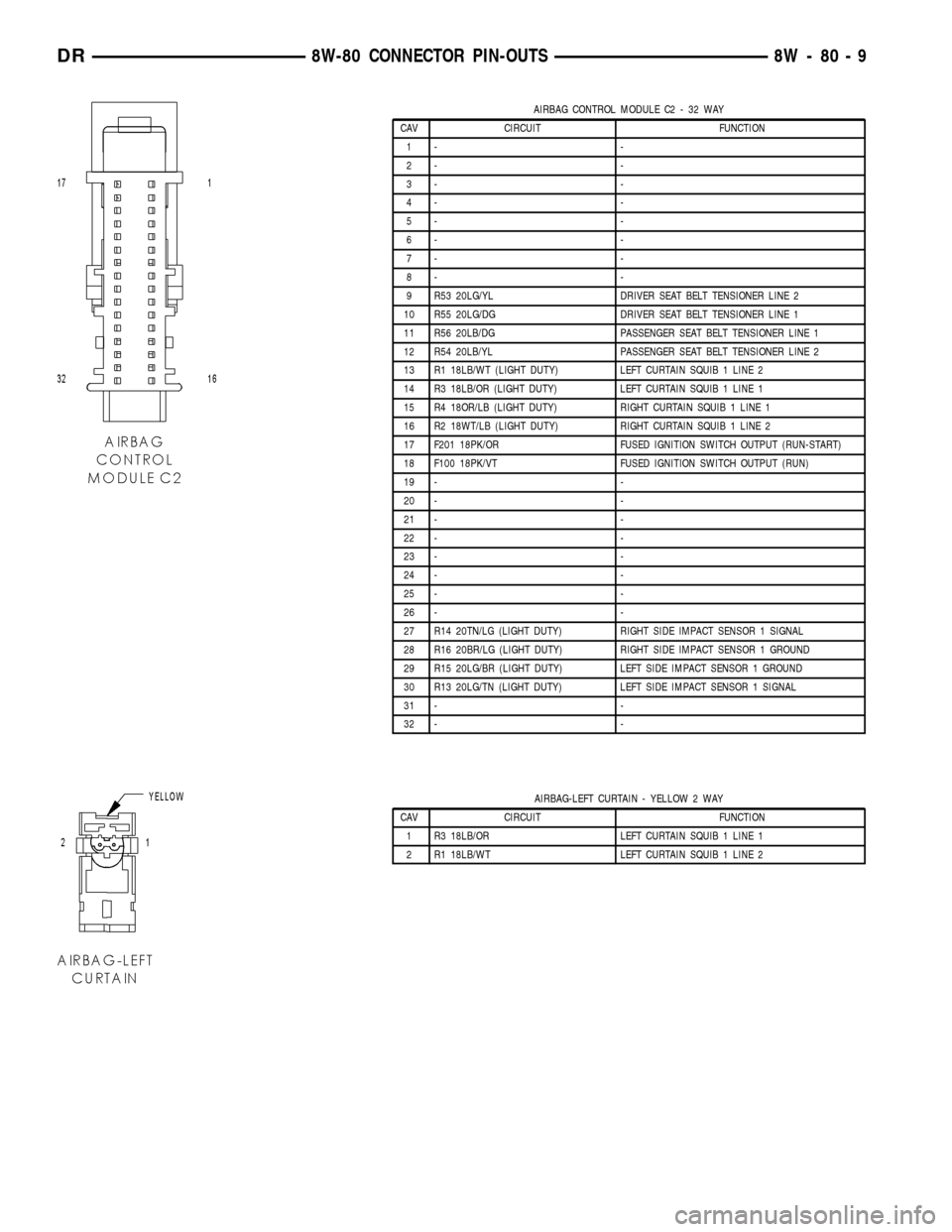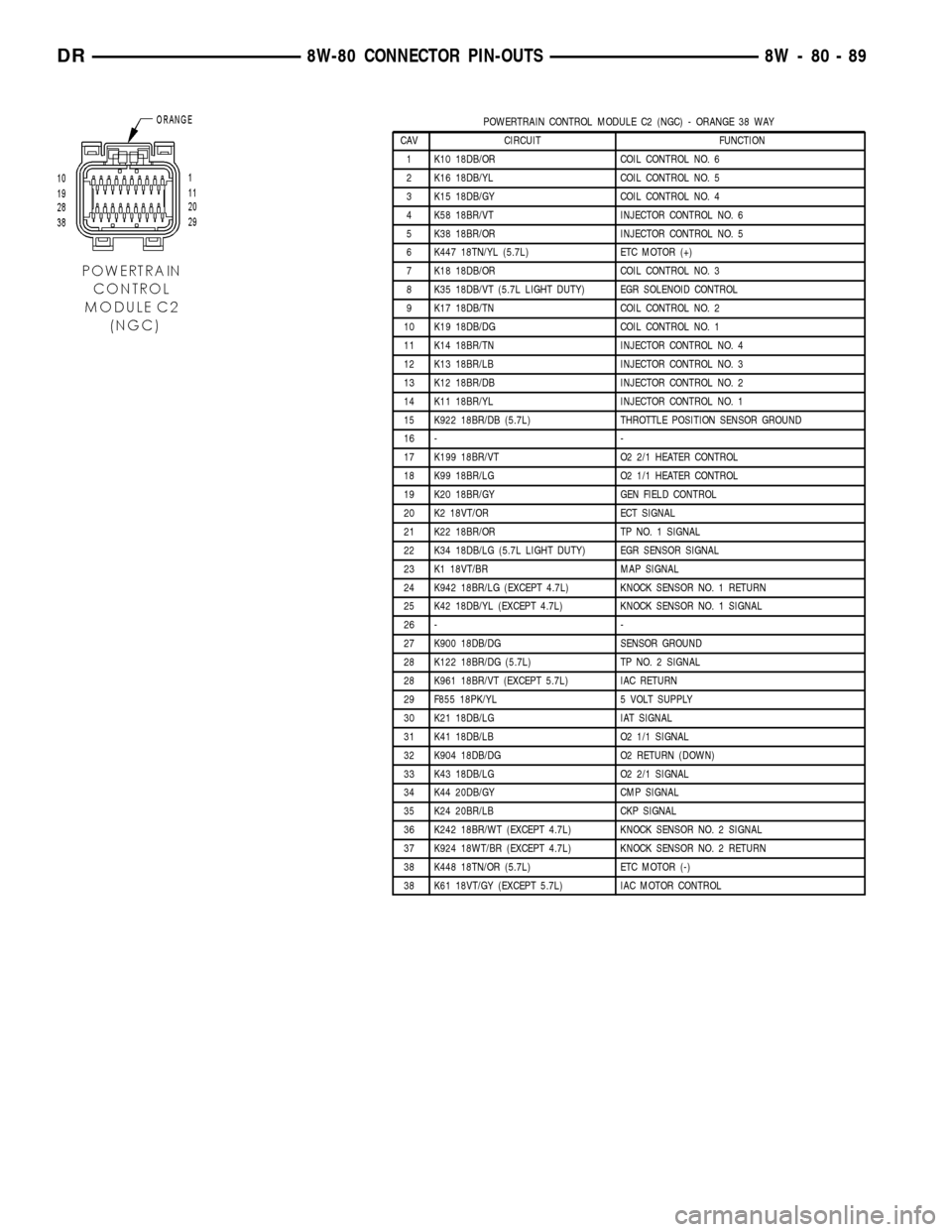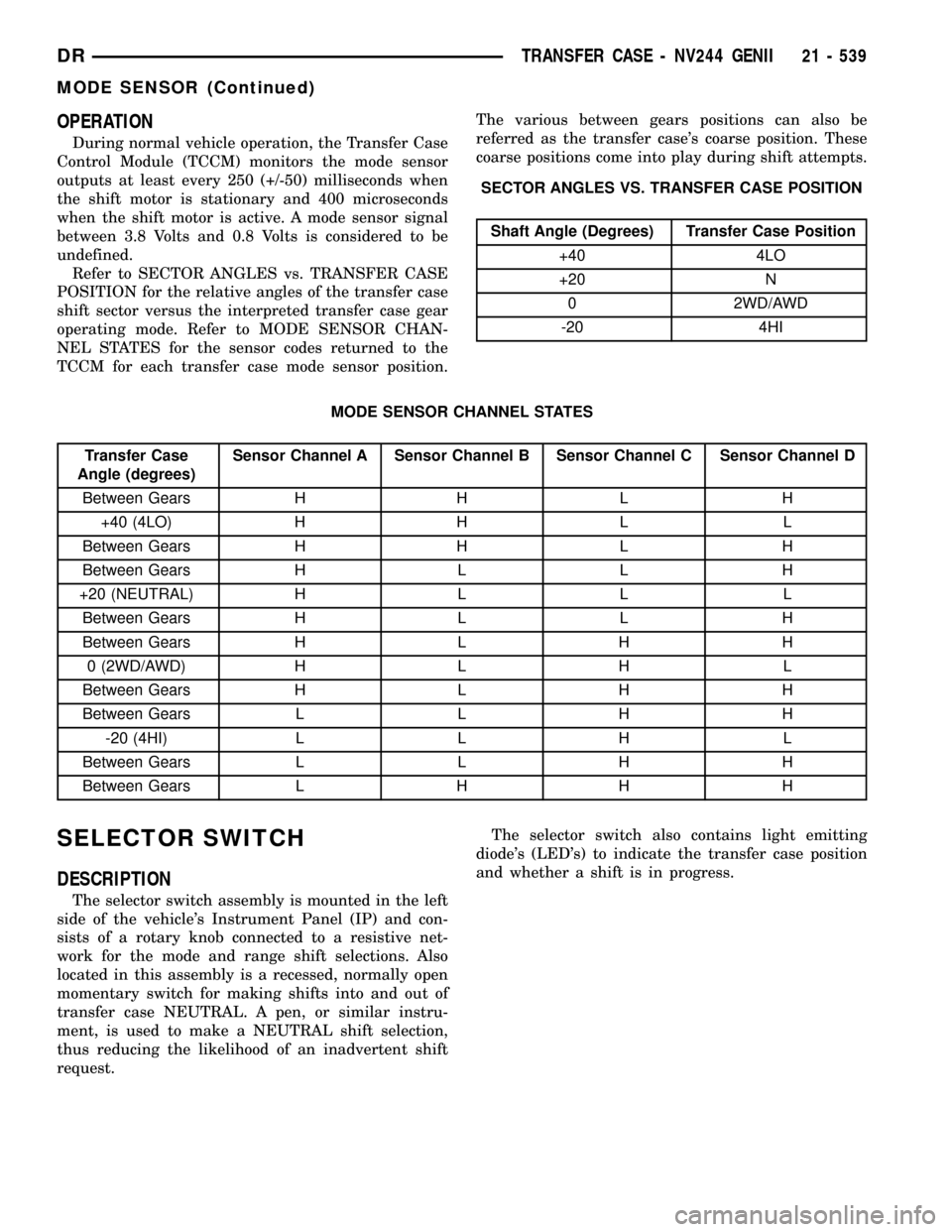1998 DODGE RAM 1500 Signal light
[x] Cancel search: Signal lightPage 1058 of 2627

AIRBAG CONTROL MODULE C2 - 32 WAY
CAV CIRCUIT FUNCTION
1- -
2- -
3- -
4- -
5- -
6- -
7- -
8- -
9 R53 20LG/YL DRIVER SEAT BELT TENSIONER LINE 2
10 R55 20LG/DG DRIVER SEAT BELT TENSIONER LINE 1
11 R56 20LB/DG PASSENGER SEAT BELT TENSIONER LINE 1
12 R54 20LB/YL PASSENGER SEAT BELT TENSIONER LINE 2
13 R1 18LB/WT (LIGHT DUTY) LEFT CURTAIN SQUIB 1 LINE 2
14 R3 18LB/OR (LIGHT DUTY) LEFT CURTAIN SQUIB 1 LINE 1
15 R4 18OR/LB (LIGHT DUTY) RIGHT CURTAIN SQUIB 1 LINE 1
16 R2 18WT/LB (LIGHT DUTY) RIGHT CURTAIN SQUIB 1 LINE 2
17 F201 18PK/OR FUSED IGNITION SWITCH OUTPUT (RUN-START)
18 F100 18PK/VT FUSED IGNITION SWITCH OUTPUT (RUN)
19 - -
20 - -
21 - -
22 - -
23 - -
24 - -
25 - -
26 - -
27 R14 20TN/LG (LIGHT DUTY) RIGHT SIDE IMPACT SENSOR 1 SIGNAL
28 R16 20BR/LG (LIGHT DUTY) RIGHT SIDE IMPACT SENSOR 1 GROUND
29 R15 20LG/BR (LIGHT DUTY) LEFT SIDE IMPACT SENSOR 1 GROUND
30 R13 20LG/TN (LIGHT DUTY) LEFT SIDE IMPACT SENSOR 1 SIGNAL
31 - -
32 - -
AIRBAG-LEFT CURTAIN - YELLOW 2 WAY
CAV CIRCUIT FUNCTION
1 R3 18LB/OR LEFT CURTAIN SQUIB 1 LINE 1
2 R1 18LB/WT LEFT CURTAIN SQUIB 1 LINE 2
DR8W-80 CONNECTOR PIN-OUTS 8W - 80 - 9
Page 1138 of 2627

POWERTRAIN CONTROL MODULE C2 (NGC) - ORANGE 38 WAY
CAV CIRCUIT FUNCTION
1 K10 18DB/OR COIL CONTROL NO. 6
2 K16 18DB/YL COIL CONTROL NO. 5
3 K15 18DB/GY COIL CONTROL NO. 4
4 K58 18BR/VT INJECTOR CONTROL NO. 6
5 K38 18BR/OR INJECTOR CONTROL NO. 5
6 K447 18TN/YL (5.7L) ETC MOTOR (+)
7 K18 18DB/OR COIL CONTROL NO. 3
8 K35 18DB/VT (5.7L LIGHT DUTY) EGR SOLENOID CONTROL
9 K17 18DB/TN COIL CONTROL NO. 2
10 K19 18DB/DG COIL CONTROL NO. 1
11 K14 18BR/TN INJECTOR CONTROL NO. 4
12 K13 18BR/LB INJECTOR CONTROL NO. 3
13 K12 18BR/DB INJECTOR CONTROL NO. 2
14 K11 18BR/YL INJECTOR CONTROL NO. 1
15 K922 18BR/DB (5.7L) THROTTLE POSITION SENSOR GROUND
16 - -
17 K199 18BR/VT O2 2/1 HEATER CONTROL
18 K99 18BR/LG O2 1/1 HEATER CONTROL
19 K20 18BR/GY GEN FIELD CONTROL
20 K2 18VT/OR ECT SIGNAL
21 K22 18BR/OR TP NO. 1 SIGNAL
22 K34 18DB/LG (5.7L LIGHT DUTY) EGR SENSOR SIGNAL
23 K1 18VT/BR MAP SIGNAL
24 K942 18BR/LG (EXCEPT 4.7L) KNOCK SENSOR NO. 1 RETURN
25 K42 18DB/YL (EXCEPT 4.7L) KNOCK SENSOR NO. 1 SIGNAL
26 - -
27 K900 18DB/DG SENSOR GROUND
28 K122 18BR/DG (5.7L) TP NO. 2 SIGNAL
28 K961 18BR/VT (EXCEPT 5.7L) IAC RETURN
29 F855 18PK/YL 5 VOLT SUPPLY
30 K21 18DB/LG IAT SIGNAL
31 K41 18DB/LB O2 1/1 SIGNAL
32 K904 18DB/DG O2 RETURN (DOWN)
33 K43 18DB/LG O2 2/1 SIGNAL
34 K44 20DB/GY CMP SIGNAL
35 K24 20BR/LB CKP SIGNAL
36 K242 18BR/WT (EXCEPT 4.7L) KNOCK SENSOR NO. 2 SIGNAL
37 K924 18WT/BR (EXCEPT 4.7L) KNOCK SENSOR NO. 2 RETURN
38 K448 18TN/OR (5.7L) ETC MOTOR (-)
38 K61 18VT/GY (EXCEPT 5.7L) IAC MOTOR CONTROL
DR8W-80 CONNECTOR PIN-OUTS 8W - 80 - 89
Page 1648 of 2627

(8) Connect battery cables to both batteries.
(9) Start engine and check for leaks.
INLET AIR TEMPERATURE
SENSOR/PRESSURE SENSOR
DESCRIPTION
The combination, dual function Inlet Air Tempera-
ture/Pressure Sensor is located on the air cleaner (fil-
ter) cover.
OPERATION
The Inlet Air Temperature/Pressure Sensor is a
combination dual-function sensor. The sensor element
extends into the intake air stream at the top of the
air filter housing. Ambient air temperature as well as
barometric pressure is monitored by this sensor. The
Engine Control Module (ECM) monitors signals from
this sensor.
REMOVAL
The Inlet Air Temperature/Pressure Sensor is
located on the air cleaner cover (Fig. 23).
(1) Disconnect electrical connector at sensor (Fig.
24).
(2) Remove two Torx-type mounting screws.
(3) Remove sensor from air cleaner cover.
(4) Check condition of sensor o-ring (Fig. 25).
INSTALLATION
(1) Check condition of sensor o-ring.
(2) Position sensor into top of air cleaner cover
with a slight twisting action.
(3) Install 2 mounting screws.
(4) Install electrical connector.
Fig. 22 FUEL INJECTOR RAIL
1 - FUEL RAIL MOUNTING BOLTS (3)
2 - INSULATED CLAMPS
3 - FUEL INJECTOR RAIL
Fig. 23 IAT/PRESSURE SENSOR LOCATION - 5.9L
DIESEL
1 - CLIPS
2 - FILTER COVER
3 - FILTER MINDERŸ
4 - INLET AIR TEMPERATURE/ PRESSURE SENSOR
5 - FILTER HOUSING
DRFUEL INJECTION - DIESEL 14 - 79
FUEL INJECTOR RAIL (Continued)
Page 2095 of 2627

INSTALLATION
(1) Install the output speed sensor into the trans-
mission case.
(2) Install the bolt to hold the output speed sensor
into the transmission case. Tighten the bolt to 11.9
N´m (105 in.lbs.).
(3) Install the wiring connector onto the output
speed sensor
(4) Verify the transmission fluid level. Add fluid as
necessary.
(5) Lower vehicle.
TOW/HAUL OVERDRIVE
SWITCH
DESCRIPTION
The tow/haul overdrive OFF (control) switch is
located in the shift lever arm (Fig. 106). The switch
is a momentary contact device that signals the PCM
to toggle current status of the overdrive function.
OPERATION
At key-on, overdrive operation is allowed. Pressing
the switch once causes the tow/haul overdrive OFF
mode to be entered and the Tow/Haul lamp to be illu-
minated. Pressing the switch a second time causesnormal overdrive operation to be restored and the
tow/haul lamp to be turned off. The tow/haul over-
drive OFF mode defaults to ON after the ignition
switch is cycled OFF and ON. The normal position
for the control switch is the ON position. The switch
must be in this position to energize the solenoid and
allow a 3-4 upshift. The control switch indicator light
illuminates only when the tow/haul overdrive switch
is turned to the OFF position, or when illuminated
by the transmission control module.
REMOVAL
(1) Using a plastic trim tool, remove the tow/haul
overdrive off switch retainer from the shift lever (Fig.
107).
Fig. 105 Output Speed Sensor
1 - OUTPUT SPEED SENSOR
2 - LINE PRESSURE SENSOR
3 - INPUT SPEED SENSOR
Fig. 106 Tow/Haul Overdrive Off Switch
Fig. 107 Tow/Haul Overdrive Off Switch Retainer
21 - 392 AUTOMATIC TRANSMISSION - 45RFE/545RFEDR
OUTPUT SPEED SENSOR (Continued)
Page 2242 of 2627

OPERATION
During normal vehicle operation, the Transfer Case
Control Module (TCCM) monitors the mode sensor
outputs at least every 250 (+/-50) milliseconds when
the shift motor is stationary and 400 microseconds
when the shift motor is active. A mode sensor signal
between 3.8 Volts and 0.8 Volts is considered to be
undefined.
Refer to SECTOR ANGLES vs. TRANSFER CASE
POSITION for the relative angles of the transfer case
shift sector versus the interpreted transfer case gear
operating mode. Refer to MODE SENSOR CHAN-
NEL STATES for the sensor codes returned to the
TCCM for each transfer case mode sensor position.The various between gears positions can also be
referred as the transfer case's coarse position. These
coarse positions come into play during shift attempts.
SECTOR ANGLES VS. TRANSFER CASE POSITION
Shaft Angle (Degrees) Transfer Case Position
+40 4LO
+20 N
0 2WD/AWD
-20 4HI
MODE SENSOR CHANNEL STATES
Transfer Case
Angle (degrees)Sensor Channel A Sensor Channel B Sensor Channel C Sensor Channel D
Between Gears H H L H
+40 (4LO) H H L L
Between Gears H H L H
Between Gears H L L H
+20 (NEUTRAL) H L L L
Between Gears H L L H
Between Gears H L H H
0 (2WD/AWD) H L H L
Between Gears H L H H
Between Gears L L H H
-20 (4HI) L L H L
Between Gears L L H H
Between Gears L H H H
SELECTOR SWITCH
DESCRIPTION
The selector switch assembly is mounted in the left
side of the vehicle's Instrument Panel (IP) and con-
sists of a rotary knob connected to a resistive net-
work for the mode and range shift selections. Also
located in this assembly is a recessed, normally open
momentary switch for making shifts into and out of
transfer case NEUTRAL. A pen, or similar instru-
ment, is used to make a NEUTRAL shift selection,
thus reducing the likelihood of an inadvertent shift
request.The selector switch also contains light emitting
diode's (LED's) to indicate the transfer case position
and whether a shift is in progress.
DRTRANSFER CASE - NV244 GENII 21 - 539
MODE SENSOR (Continued)
Page 2508 of 2627

cal indexing to the defrost door, as it is electronically
calibrated by the heater-A/C control module. The
defrost door actuator cannot be adjusted or repaired
and, if damaged or faulty, it must be replaced.
OPERATION
The defrost door actuator is connected to the heat-
er-A/C control module through the vehicle electrical
system by a dedicated two-wire lead and connector
from the HVAC wire harness. The defrost door actua-
tor can move the defrost door in two directions.
When the heater-A/C control module pulls the volt-
age on one side of the motor connection high and the
other connection low, the defrost door will move in
one direction. When the module reverses the polarity
of the voltage to the motor, the defrost door moves in
the opposite direction. When the module makes the
voltage to both connections high or both connections
low, the defrost door stops and will not move. These
same motor connections also provide a feedback sig-
nal to the heater-A/C control module. This feedback
signal allows the module to monitor the operation
and relative positions of the defrost door actuator
and the defrost door. The heater-A/C control module
learns the defrost door stop positions during the cal-
ibration procedure and will store a Diagnostic Trou-
ble Code (DTC) for any problems it detects in the
defrost door actuator circuits. The defrost door actua-
tor can be diagnosed using a DRBIIItscan tool.
Refer to Body Diagnostic Procedures.
REMOVAL
WARNING: ON VEHICLES EQUIPPED WITH AIR-
BAGS, DISABLE THE AIRBAG SYSTEM BEFORE
ATTEMPTING ANY STEERING WHEEL, STEERING
COLUMN, OR INSTRUMENT PANEL COMPONENT
DIAGNOSIS OR SERVICE. DISCONNECT AND ISO-
LATE THE BATTERY NEGATIVE (GROUND) CABLE,
THEN WAIT TWO MINUTES FOR THE AIRBAG SYS-
TEM CAPACITOR TO DISCHARGE BEFORE PER-
FORMING FURTHER DIAGNOSIS OR SERVICE. THIS
IS THE ONLY SURE WAY TO DISABLE THE AIRBAG
SYSTEM. FAILURE TO TAKE THE PROPER PRE-
CAUTIONS COULD RESULT IN AN ACCIDENTAL
AIRBAG DEPLOYMENT AND POSSIBLE PERSONAL
INJURY.
(1) Disconnect and isolate the battery negative
cable.
(2) Remove the instrument panel from the vehicle
(Refer to 23 - BODY/INSTRUMENT PANEL/IN-
STRUMENT PANEL ASSEMBLY - REMOVAL).
(3) Disconnect the wire harness connector from the
defrost door actuator (Fig. 19).
(4) Remove the screws that secure the defrost door
actuator to the HVAC housing.(5) Remove the defrost door actuator from the
HVAC housing.
INSTALLATION
(1) Position the defrost door actuator into the
HVAC housing. If necessary, rotate the actuator
slightly to align the splines on the actuator output
sleeve with those on the defrost door linkage.
(2) Install and tighten the screws that secure the
defrost door actuator to the HVAC housing. Tighten
the screws to 2 N´m (17 in. lbs.).
(3) Connect the HVAC wire harness connector to
the defrost door actuator.
(4) Install the instrument panel (Refer to 23 -
BODY/INSTRUMENT PANEL/INSTRUMENT
PANEL ASSEMBLY - INSTALLATION).
(5) Reconnect the battery negative cable.
Fig. 19 HVAC Housing - Dual Zone Shown, Single
Zone Typical
1 - NUT
2 - PASSENGER BLEND DOOR ACTUATOR
3 - NUT
4 - INLET BAFFLE
5 - RECIRCULATION DOOR ACTUATOR
6 - RECIRCULATION DOOR
7 - DRIVER SIDE BLEND DOOR ACTUATOR
8 - HVAC HOUSING
9 - BOLT
10 - DEFROSTER DOOR ACTUATOR
11 - MODE DOOR ACTUATOR
DRCONTROLS 24 - 21
DEFROST DOOR ACTUATOR (Continued)
Page 2510 of 2627

(2) Assemble the HVAC housing (Refer to 24 -
HEATING & AIR CONDITIONING/DISTRIBUTION/
HVAC HOUSING - ASSEMBLY).
(3) Connect the HVAC wire harness connector to
the evaporator temperature sensor.
(4) Install the HVAC housing (Refer to 24 - HEAT-
ING & AIR CONDITIONING/DISTRIBUTION/HVAC
HOUSING - INSTALLATION).
(5) Reconnect the battery negative cable.
MODE DOOR ACTUATOR
DESCRIPTION
The mode door actuator is a reversible 12-volt
Direct Current (DC) servo motor. The mode door
actuator is located on the HVAC housing, behind the
instrument panel and is mechanically connected to
the mode door.
The mode door actuator is interchangeable with
the actuators for the blend door(s), defrost door and
the recirculation door. Each actuator is contained
within an identical black molded plastic housing with
an integral wire connector receptacle. Integral
mounting tabs allow the actuator to be secured with
three screws to the HVAC housing. Each actuator
also has an identical output shaft with splines that
connects it to the linkage that drives the proper door.
The mode door actuator does not require mechanical
indexing to the mode door linkage, as it is electroni-
cally calibrated by the heater-A/C control module.
The mode door actuator cannot be adjusted or
repaired and, if damaged or faulty, it must be
replaced.
OPERATION
The mode door actuator is connected to the A/C-
heater control through the vehicle electrical system
by a dedicated two-wire lead and connector from the
HVAC wire harness. The mode door actuator can
move the mode door in two directions. When the A/C-
heater control pulls the voltage on one side of the
motor connection high and the other connection low,
the mode door will move in one direction. When the
A/C-heater control reverses the polarity of the volt-
age to the motor, the mode door moves in the oppo-
site direction. When the A/C-heater control makes
the voltage to both connections high or both connec-
tions low, the mode door stops and will not move.
These same motor connections also provide a feed-
back signal to the A/C-heater control. This feedback
signal allows the A/C-heater control to monitor the
operation and relative position of the mode door
actuator and the mode door. The A/C-heater control
learns the mode door stop positions during the cali-
bration procedure and will store a diagnostic troublecode (DTC) for any problems it detects in the mode
door actuator circuits.
The mode door actuator can be diagnosed using a
DRBIIItscan tool. Refer to Body Diagnostic Proce-
dures for more information. The mode door actuator
cannot be adjusted or repaired and, if damaged or
faulty, it must be replaced.
REMOVAL
WARNING: ON VEHICLES EQUIPPED WITH AIR-
BAGS, DISABLE THE AIRBAG SYSTEM BEFORE
ATTEMPTING ANY STEERING WHEEL, STEERING
COLUMN, OR INSTRUMENT PANEL COMPONENT
DIAGNOSIS OR SERVICE. DISCONNECT AND ISO-
LATE THE BATTERY NEGATIVE (GROUND) CABLE,
THEN WAIT TWO MINUTES FOR THE AIRBAG SYS-
TEM CAPACITOR TO DISCHARGE BEFORE PER-
FORMING FURTHER DIAGNOSIS OR SERVICE. THIS
IS THE ONLY SURE WAY TO DISABLE THE AIRBAG
SYSTEM. FAILURE TO TAKE THE PROPER PRE-
CAUTIONS COULD RESULT IN ACCIDENTAL AIR-
BAG DEPLOYMENT AND POSSIBLE PERSONAL
INJURY.
(1) Disconnect and isolate the battery negative
cable.
(2) Remove the instrument panel from the vehicle
(Refer to 23 - BODY/INSTRUMENT PANEL/IN-
STRUMENT PANEL ASSEMBLY - REMOVAL).
(3) Disconnect the wire harness connector from the
mode door actuator (Fig. 22).
(4) Remove the screws that secure the mode door
actuator to the HVAC housing.
(5) Remove the mode door actuator from the HVAC
housing.
INSTALLATION
(1) Position the mode door actuator onto the HVAC
housing. If necessary, rotate the actuator slightly to
align the splines on the actuator output sleeve with
those on the mode door linkage.
(2) Install and tighten the screws that secure the
mode door actuator to the HVAC housing. Tighten
the screws to 2 N´m (17 in. lbs.).
(3) Connect the HVAC wire harness connector to
the mode door actuator.
(4) Install the instrument panel (Refer to 23 -
BODY/INSTRUMENT PANEL/INSTRUMENT
PANEL ASSEMBLY - INSTALLATION).
(5) Reconnect the battery negative cable.
DRCONTROLS 24 - 23
EVAPORATOR TEMPERATURE SENSOR (Continued)
Page 2605 of 2627

INTAKE AIR HEATER - OPERATION.......14-80
INTAKE AIR HEATER - REMOVAL........14-80
INTAKE AIR HEATER RELAY -
DESCRIPTION.......................14-82
INTAKE AIR HEATER RELAY -
INSTALLATION.......................14-82
INTAKE AIR HEATER RELAY -
OPERATION.........................14-82
INTAKE AIR HEATER RELAY - REMOVAL . . 14-82
INTAKE AIR TEMPERATURE SENSOR -
DESCRIPTION.......................14-30
INTAKE AIR TEMPERATURE SENSOR -
INSTALLATION.......................14-31
INTAKE AIR TEMPERATURE SENSOR -
OPERATION.........................14-30
INTAKE AIR TEMPERATURE SENSOR -
REMOVAL..........................14-30
INTAKE AIR TEMPERATURE SENSOR/
MAP SENSOR - DESCRIPTION..........14-82
INTAKE AIR TEMPERATURE SENSOR/
MAP SENSOR - INSTALLATION..........14-82
INTAKE AIR TEMPERATURE SENSOR/
MAP SENSOR - OPERATION............14-82
INTAKE AIR TEMPERATURE SENSOR/
MAP SENSOR - REMOVAL.............14-82
INTAKE MANIFOLD - CLEANING....9-160,9-226,
9-297
INTAKE MANIFOLD - DESCRIPTION . 9-159,9-225,
9-72
INTAKE MANIFOLD - INSPECTION . . 9-160,9-226,
9-297
INTAKE MANIFOLD - INSTALLATION.....9-160,
9-226,9-298,9-73
INTAKE MANIFOLD - REMOVAL....9-159,9-226,
9-297,9-73
INTAKE MANIFOLD LEAKAGE -
DIAGNOSIS AND TESTING........9-159,9-225
INTAKE MANIFOLD LEAKS - DIAGNOSIS
AND TESTING........................9-72
INTAKE SYSTEM - INSTALLATION, AIR....9-199
INTAKE SYSTEM - REMOVAL, AIR.......9-199
INTAKE/EXHAUST VALVES & SEATS -
DESCRIPTION..............9-123,9-256,9-28
INTAKE/EXHAUST VALVES & SEATS -
INSTALLATION...................9-124,9-30
INTAKE/EXHAUST VALVES & SEATS -
REMOVAL......................9-124,9-29
INTEGRATED POWER MODULE -
DESCRIPTION.....................8W-97-3
INTEGRATED POWER MODULE -
INSTALLATION....................8W-97-4
INTEGRATED POWER MODULE -
OPERATION.......................8W-97-3
INTEGRATED POWER MODULE -
REMOVAL........................8W-97-3
INTERIOR - CAUTION.................23-62
INTERLOCK - ADJUSTMENTS, BRAKE
TRANSMISSION SHIFT.........21-196,21-365
INTERLOCK - DIAGNOSIS AND TESTING,
BRAKE TRANSMISSION SHIFT . . . 21-196,21-364
INTERLOCK SYSTEM - DESCRIPTION,
BRAKE TRANSMISSION SHIFT . . . 21-196,21-364
INTERLOCK SYSTEM - OPERATION,
BRAKE TRANSMISSION SHIFT . . . 21-196,21-364
INTERNATIONAL SYMBOLS -
DESCRIPTION......................Intro.-5
INVERTED FLARING - STANDARD
PROCEDURE, DOUBLE.................5-10
IOD FUSE - DESCRIPTION...........8W-97-6
IOD FUSE - INSTALLATION...........8W-97-7
IOD FUSE - OPERATION.............8W-97-6
IOD FUSE - REMOVAL..............8W-97-7
ISO FLARING - STANDARD PROCEDURE
. . . 5-11
ISOLATORS - INSTALLATION, BODY
......23-37
ISOLATORS - REMOVAL, BODY
.........23-36
JOINT - DIAGNOSIS AND TESTING,
LOWER BALL
....................2-19,2-34
JOINT - DIAGNOSIS AND TESTING,
UPPER BALL
.....................2-27,2-36
JOINT - INSTALLATION, LOWER BALL
. 2-20,2-35
JOINT - INSTALLATION, UPPER BALL
.....2-36
JOINT - REMOVAL, LOWER BALL
.....2-19,2-35
JOINT - REMOVAL, UPPER BALL
.........2-36
JOINT-INNER - INSTALLATION, CV
........3-25
JOINT-INNER - REMOVAL, CV
............3-25
JOINT-OUTER - INSTALLATION, CV
........3-23
JOINT-OUTER - REMOVAL, CV
...........3-22JOINTS - ASSEMBLY, DOUBLE CARDAN
UNIVERSAL..........................3-17
JOINTS - DISASSEMBLY, DOUBLE
CARDAN UNIVERSAL..................3-16
JOUNCE BUMPER - INSTALLATION.......2-43
JOUNCE BUMPER - REMOVAL...........2-43
JOURNAL CLEARANCE - STANDARD
PROCEDURE, CONNECTING ROD
BEARING AND CRANKSHAFT...........9-272
JUMP STARTING - STANDARD
PROCEDURE.........................0-19
JUNCTION BLOCK - INSTALLATION,
BRAKE..............................5-24
JUNCTION BLOCK - REMOVAL, BRAKE....5-24
KEY CYLINDER - INSTALLATION.........19-12
KEY CYLINDER - REMOVAL............19-12
KEY IMMOBILIZER MODULE -
DESCRIPTION, SENTRY................8E-13
KEY IMMOBILIZER MODULE -
INSTALLATION, SENTRY...............8E-15
KEY IMMOBILIZER MODULE -
OPERATION, SENTRY.................8E-13
KEY IMMOBILIZER MODULE - REMOVAL,
SENTRY............................8E-15
KEY IMMOBILIZER MODULE (SKIM) -
DESCRIPTION, SENTRY................8Q-1
KEY IMMOBILIZER MODULE (SKIM) -
OPERATION, SENTRY..................8Q-2
KEY IMMOBILIZER SYSTEM INDICATOR
LAMP - DESCRIPTION, SENTRY..........8Q-5
KEY IMMOBILIZER SYSTEM INDICATOR
LAMP - OPERATION, SENTRY...........8Q-5
KEY IMMOBILIZER SYSTEM
INITIALIZATION, STANDARD
PROCEDURE - SENTRY................8Q-3
KEY IMMOBILIZER SYSTEM (SKIS) -
DESCRIPTION, SENTRY................8Q-1
KEY IMMOBILIZER SYSTEM (SKIS) -
OPERATION, SENTRY..................8Q-2
KEY IMMOBILIZER SYSTEM
TRANSPONDER PROGRAMMING,
STANDARD PROCEDURE - SENTRY.......8Q-4
KEY LOCK CYLINDER - DIAGNOSIS AND
TESTING, IGNITION SWITCH............19-11
KEY-IN IGNITION SWITCH -
DESCRIPTION.......................19-11
KEYLESS ENTRY MODULE -
DESCRIPTION, REMOTE................8N-7
KEYLESS ENTRY MODULE - DIAGNOSIS
AND TESTING, REMOTE................8N-7
KEYLESS ENTRY MODULE -
INSTALLATION, REMOTE...............8N-8
KEYLESS ENTRY MODULE - OPERATION,
REMOTE............................8N-7
KEYLESS ENTRY MODULE - REMOVAL,
REMOTE............................8N-7
KEYLESS ENTRY TRANSMITTER -
DIAGNOSIS AND TESTING, REMOTE......8N-8
KEYLESS ENTRY TRANSMITTER -
SPECIFICATIONS, REMOTE..............8N-9
KNOB RELEASE - INSTALLATION, TILT
LEVER.............................19-16
KNOB RELEASE - REMOVAL, TILT LEVER . . 19-16
KNOCK SENSOR - DESCRIPTION.........8I-14
KNOCK SENSOR - INSTALLATION........8I-15
KNOCK SENSOR - OPERATION..........8I-14
KNOCK SENSOR - REMOVAL............8I-15
KNUCKLE - DESCRIPTION...............2-18
KNUCKLE - INSTALLATION..........2-19,2-37
KNUCKLE - OPERATION................2-18
KNUCKLE - REMOVAL..............2-18,2-37
LABEL - DESCRIPTION, VEHICLE
CERTIFICATION....................Intro.-11
LAMP - DESCRIPTION, DOME...........8L-26
LAMP - DESCRIPTION, READING........8L-28
LAMP - DESCRIPTION, SENTRY KEY
IMMOBILIZER SYSTEM INDICATOR.......8Q-5
LAMP - INSTALLATION, CAB CLEARANCE . 8L-12
LAMP - INSTALLATION, CENTER HIGH
MOUNTED STOP.....................8L-11
LAMP - INSTALLATION, DOME..........8L-26
LAMP - INSTALLATION, FENDER
MARKER
...........................8L-18
LAMP - INSTALLATION, FOG
............8L-12
LAMP - INSTALLATION, LICENSE PLATE
. . 8L-17
LAMP - INSTALLATION, PARK/TURN
SIGNAL
............................8L-21
LAMP - INSTALLATION, READING
........8L-29LAMP - INSTALLATION, TAILGATE
MARKER...........................8L-18
LAMP - INSTALLATION, UNDERHOOD....8L-25
LAMP - OPERATION, DOME............8L-26
LAMP - OPERATION, READING..........8L-28
LAMP - OPERATION, SENTRY KEY
IMMOBILIZER SYSTEM INDICATOR.......8Q-5
LAMP - REMOVAL, CAB CLEARANCE.....8L-11
LAMP - REMOVAL, CENTER HIGH
MOUNTED STOP.....................8L-11
LAMP - REMOVAL, DOME..............8L-26
LAMP - REMOVAL, FENDER MARKER....8L-17
LAMP - REMOVAL, FOG...............8L-12
LAMP - REMOVAL, LICENSE PLATE......8L-17
LAMP - REMOVAL, PARK/TURN SIGNAL . . 8L-21
LAMP - REMOVAL, READING...........8L-28
LAMP - REMOVAL, TAILGATE MARKER . . . 8L-18
LAMP - REMOVAL, UNDERHOOD........8L-25
LAMP INDICATOR - DESCRIPTION,
CARGO.............................8J-20
LAMP INDICATOR - OPERATION, CARGO . . 8J-20
LAMP (MIL) - DESCRIPTION,
MALFUNCTION INDICATOR.............8J-31
LAMP (MIL) - OPERATION,
MALFUNCTION INDICATOR.............8J-31
LAMP OUT INDICATOR - DESCRIPTION . . . 8J-29
LAMP OUT INDICATOR - OPERATION.....8J-29
LAMP RELAY - DESCRIPTION, FOG......8L-12
LAMP RELAY - DESCRIPTION, PARK.....8L-20
LAMP RELAY - DIAGNOSIS AND
TESTING, PARK......................8L-20
LAMP RELAY - INSTALLATION, FOG......8L-13
LAMP RELAY - INSTALLATION, PARK.....8L-21
LAMP RELAY - OPERATION, FOG........8L-13
LAMP RELAY - OPERATION, PARK.......8L-20
LAMP RELAY - REMOVAL, FOG.........8L-13
LAMP RELAY - REMOVAL, PARK........8L-21
LAMP REPLACEMENT - STANDARD
PROCEDURE, MODULE................8M-3
LAMP REPLACEMENT - STANDARD
PROCEDURE, READING/COURTESY.......8M-3
LAMP SWITCH - DESCRIPTION, BACKUP . . . 8L-8
LAMP SWITCH - DESCRIPTION, BRAKE....8L-9
LAMP SWITCH - DIAGNOSIS AND
TESTING, BACKUP.....................8L-8
LAMP SWITCH - DIAGNOSIS AND
TESTING, BRAKE.....................8L-10
LAMP SWITCH - INSTALLATION, BRAKE . . 8L-11
LAMP SWITCH - OPERATION, BACKUP....8L-8
LAMP SWITCH - OPERATION, BRAKE......8L-9
LAMP SWITCH - REMOVAL, BRAKE......8L-10
LAMP UNIT - INSTALLATION, CENTER
HIGH MOUNTED STOP................8L-11
LAMP UNIT - INSTALLATION, LICENSE
PLATE .............................8L-17
LAMP UNIT - INSTALLATION,
UNDERHOOD........................8L-25
LAMP UNIT - REMOVAL, CENTER HIGH
MOUNTED STOP.....................8L-11
LAMP UNIT - REMOVAL, LICENSE PLATE . . 8L-17
LAMP UNIT - REMOVAL, UNDERHOOD . . . 8L-25
LAMPS, SPECIFICATIONS - EXTERIOR.....8L-7
LAMPS/LIGHTING - EXTERIOR -
DESCRIPTION........................8L-2
LAMPS/LIGHTING - EXTERIOR -
DIAGNOSIS AND TESTING..............8L-3
LAMPS/LIGHTING - EXTERIOR -
OPERATION..........................8L-2
LAMP/SWITCH - INSTALLATION, GLOVE
BOX ...............................8L-28
LAMP/SWITCH - REMOVAL, GLOVE BOX . . 8L-27
LASH ADJUSTER - DIAGNOSIS AND
TESTING, HYDRAULIC.............9-125,9-32
LASH ADJUSTMENT AND VERIFICATION
- STANDARD PROCEDURE, VALVE.......9-259
LATCH - INSTALLATION.....23-16,23-23,23-32,
23-47
LATCH - INSTALLATION, GLOVE BOX.....23-52
LATCH - INSTALLATION, UNDER SEAT
STORAGE BIN.......................23-80
LATCH - REMOVAL
....23-16,23-23,23-32,23-47
LATCH - REMOVAL, GLOVE BOX
.........23-52
LATCH - REMOVAL, UNDER SEAT
STORAGE BIN
.......................23-80
LATCH RELEASE CABLE/HANDLE
ASSEMBLY - INSTALLATION
............23-47
LATCH RELEASE CABLE/HANDLE
ASSEMBLY - REMOVAL
................23-47
18 INDEXDR
Description Group-Page Description Group-Page Description Group-Page